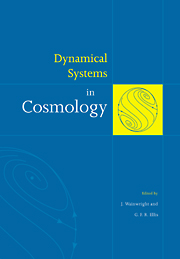Book contents
- Frontmatter
- Contents
- List of contributors
- Preface
- Introduction
- Part one Background
- 1 Geometry of cosmological models
- 2 Friedmann–Lemaître universes
- 3 Cosmological observations
- 4 Introduction to dynamical systems
- Part two Spatially homogeneous cosmologies
- Part three Inhomogeneous cosmologies
- Part four Conclusion
- References
- Subject index
4 - Introduction to dynamical systems
Published online by Cambridge University Press: 10 November 2009
- Frontmatter
- Contents
- List of contributors
- Preface
- Introduction
- Part one Background
- 1 Geometry of cosmological models
- 2 Friedmann–Lemaître universes
- 3 Cosmological observations
- 4 Introduction to dynamical systems
- Part two Spatially homogeneous cosmologies
- Part three Inhomogeneous cosmologies
- Part four Conclusion
- References
- Subject index
Summary
In this chapter we give a brief overview of some aspects of the theory of dynamical systems. We assume that the reader is familiar with the theory of systems of linear differential equations, and with the elementary stability analysis of equilibrium points of systems of non–linear differential equations (e.g. Perko 1991). We emphasize instead the fundamental concept of the flow and various other geometrical concepts such as α– and ω–limit sets, attractors and stable/unstable manifolds, which have proved useful in applications in cosmology. In the interest of readability we have stated some of the definitions and theorems in a simplified form; full details may be found in the references cited. One important aspect of the theory that we do not discuss due to limitations of space is structural stability and bifurcations. We refer to Perko (1991, chapter 4) for an introduction to these matters. We also note that the discussion of chaotic dynamical systems is deferred until Chapter 11.
To date, applications of the theory of dynamical systems in cosmology have been confined to the finite dimensional case, corresponding to systems of ordinary differential equations, although in Chapter 13 we obtain a glimpse of the potential for using infinite dimensional dynamical systems. We restrict our discussion to the finite dimensional case, referring the interested reader to books such as Hale (1988), Temam (1988a,b) and Vishik (1992) for an introduction to the infinite dimensional case.
- Type
- Chapter
- Information
- Dynamical Systems in Cosmology , pp. 84 - 104Publisher: Cambridge University PressPrint publication year: 1997
- 13
- Cited by



